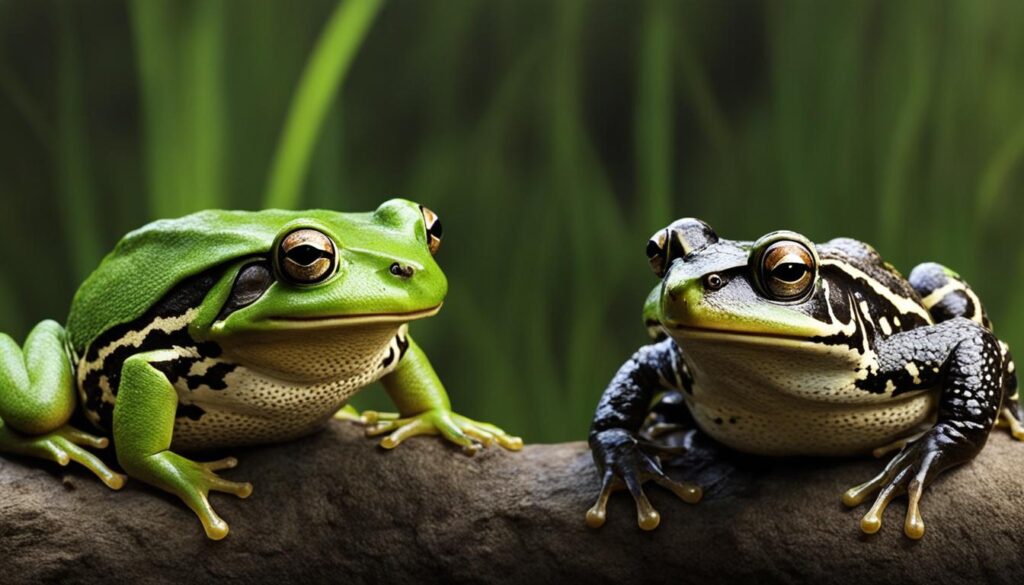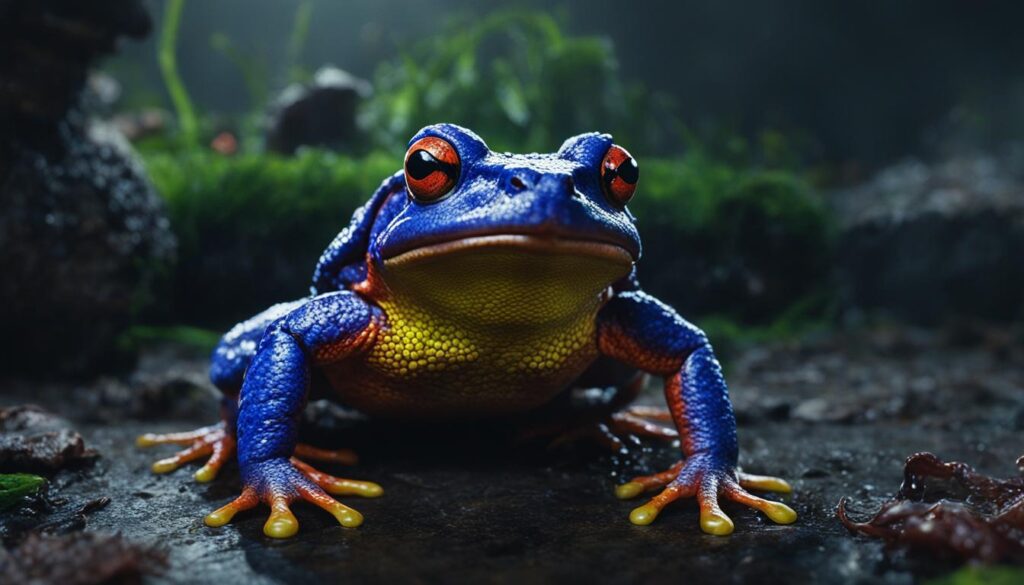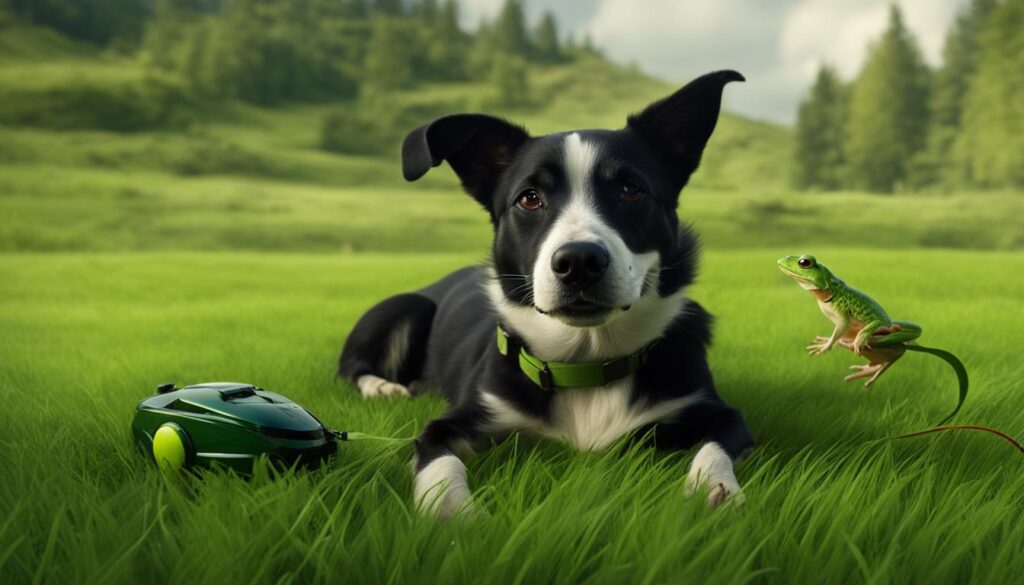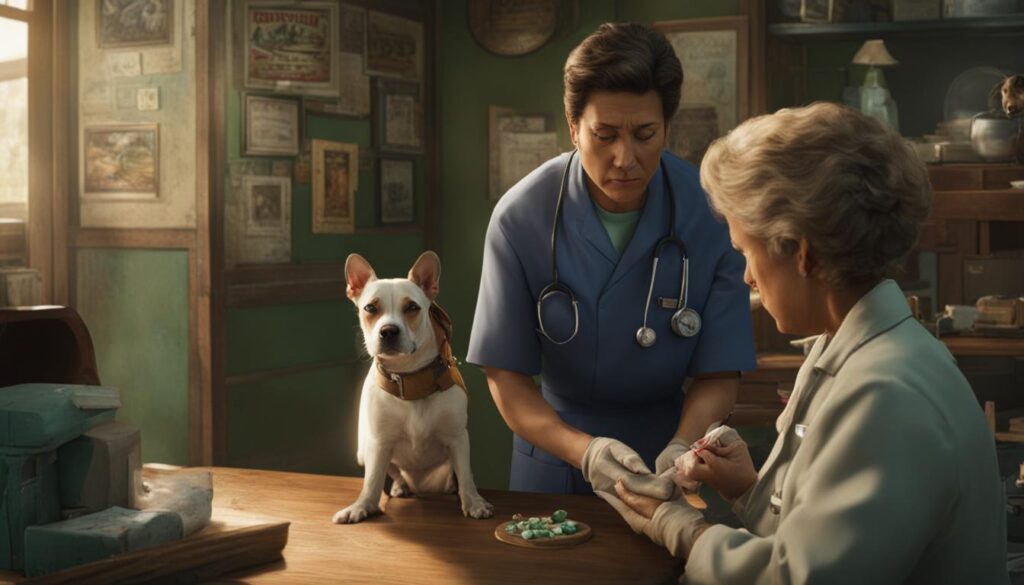I am often asked whether frogs are poisonous to dogs and what safety measures should be taken to protect our beloved pets. While frogs themselves are not generally toxic to dogs, there are certain frog species that can pose a danger. Understanding the risks and taking necessary precautions can help prevent frog poisoning in dogs and ensure their safety when venturing outdoors.
As dog owners, it’s important to be able to differentiate between frogs and potentially toxic toads. Knowing the physical characteristics of each species and being aware of the harmful effects of frogs on dogs is essential in keeping our furry companions safe.
Here are some key points to consider when it comes to frogs and the safety of our canine friends:
Key Takeaways:
- While frogs themselves are not poisonous to dogs, there are certain toxic species of toads that can pose a danger.
- It is important to learn how to distinguish between frogs and toads and be aware of the symptoms of frog poisoning in dogs.
- The Colorado River Toad and the Giant Toad are two common toad species found in the southwestern parts of the United States that can be poisonous to dogs.
- When a dog comes into contact with a toxic toad, they may exhibit various symptoms of frog toxicity, such as excess drooling, seizures, hyperthermia, and foaming at the mouth.
- To prevent frog poisoning in dogs, it’s essential to keep an eye on your dog during outdoor playtime and create a safe backyard environment.
Frog vs. Toad: What’s the Difference?

Frogs and toads have distinct physical characteristics that set them apart. Identifying these differences is crucial in ensuring the safety of your dog. Let’s take a closer look at what sets frogs and toads apart.
Distinguishing Physical Characteristics
Frogs typically have slimy, mucus-covered skin that appears smooth and moist. Their skin is more permeable, allowing them to absorb water and dissolve oxygen. Frogs also have longer hind legs, designed for jumping and swimming. These adaptations make them well-suited for their habitat near bodies of water.
On the other hand, toads have rougher, thicker skin with a dry, warty texture. Their skin secretes a mild toxin that acts as a defense mechanism, deterring potential predators. Toads have shorter hind legs compared to frogs and tend to have a slower hopping motion. They are commonly found in yards and gardens.
Identifying Frog and Toad Species
When it comes to identifying specific frog and toad species, it can be challenging without proper knowledge. However, some common species can be distinguished visually:
| Frogs | Toads |
|---|---|
| Tree Frogs | American Toad |
| Leopard Frog | Cane Toad |
| Poison Dart Frog | Colorado River Toad |
Knowing the specific species in your area can help you better understand the potential risks and take appropriate precautions.
Remember, identification can be challenging, and it’s always best to consult with local wildlife or herpetology experts for proper identification if needed.
By familiarizing yourself with the physical characteristics and visual identification of frogs and toads, you become better equipped to protect your dog from potential toxicity. Stay vigilant and ensure a safe environment for your furry friend.
Dangerous Toads for Dogs

When it comes to toxic toad species that pose a danger to dogs, two common ones found in the southwestern parts of the United States are the Colorado River Toad and the Giant Toad. These toads have the ability to secrete venom from their glands when threatened, and the compounds in the venom can cause serious adverse effects in dogs. It is important for dog owners to recognize the risks of encountering these poisonous toads in order to prevent frog poisoning in their pets.
To help you understand the potential risks better, here is a comparison of the key characteristics of the Colorado River Toad and the Giant Toad:
| Toad Species | Physical Characteristics | Geographical Distribution |
|---|---|---|
| Colorado River Toad | Large size, stocky body, smooth skin with dark spots, range in color from olive to greenish-gray | Found in the southwestern parts of the United States, primarily in Arizona, Texas, New Mexico, and southern California |
| Giant Toad | Massive size, warty and bumpy skin with dark patterns, range in color from gray to brown | Native to Central and South America but also found in pockets of Florida and Hawaii |
Recognizing the presence of these toxic toad species in your area is crucial to protect your furry companion from the risks associated with poisonous toads. By staying informed and being vigilant, you can take the necessary precautions to keep your dog safe from frog poisoning.
Symptoms of Frog Toxicity in Dogs

When a dog comes into contact with a toxic toad, they may exhibit various symptoms of frog toxicity.
These can include:
- Excess drooling
- Seizures or convulsions
- Hyperthermia
- Yellow vomit
- Diarrhea
- Dilated pupils
- Irregular heartbeat
- Foaming at the mouth
It’s important to recognize these signs and seek veterinary care immediately, as untreated toad venom can be deadly for dogs.
Recognizing these symptoms is crucial for the early identification of frog poisoning in dogs. Prompt medical attention is necessary to prevent further complications and ensure the best outcome for your pet.
Preventing Frog Poisoning in Dogs

To prevent frog poisoning in dogs, it’s essential to take certain precautions. Here are some dog safety tips around frogs:
- Keep a close eye on your dog during outdoor playtime to ensure they don’t come into contact with toxic toads.
- If you suspect your dog has encountered a toad, flush out their mouth with water and contact a veterinarian immediately.
- Create a safe backyard environment by removing standing water, as frogs are attracted to moist areas. This helps in keeping dogs away from toxic toads.
- Ensure proper yard maintenance, such as regularly mowing the lawn and trimming bushes, to minimize hiding spots for frogs and toads.
- Monitor outdoor playtime and restrict access to areas where frogs are commonly found, such as ponds or marshy areas.
By following these dog safety tips around frogs and creating a safe backyard environment, you can significantly reduce the risk of frog-related dangers for dogs.
Treating Frog Poisoning in Dogs

If your dog has been poisoned by a toxic toad, immediate veterinary care is vital. To ensure the best possible outcome, it’s important to follow the guidance of a veterinarian who can provide the necessary emergency treatment for frog poisoning.
One of the primary steps in treating frog poisoning is to induce vomiting in dogs. This helps remove any toxin that may have been ingested. Induced vomiting can be done by the veterinarian using safe and controlled methods.
Additionally, veterinary care for poisoned dogs may involve supportive measures such as administering intravenous fluids. These fluids help to stabilize the dog’s condition and prevent dehydration. Medications may also be prescribed to manage symptoms and prevent further complications.
It’s crucial to recognize the importance of seeking professional help when it comes to treating toad venom exposure in dogs. Veterinary care provides the expertise and resources needed to effectively address frog poisoning, ensuring the best chances of recovery for your beloved pet.
Remember, never attempt to treat or induce vomiting in dogs at home without veterinary guidance. Improper handling can worsen the situation or lead to additional complications. Always consult a veterinarian for proper diagnosis and treatment.
By seeking prompt veterinary care and following the guidance of professionals, you can help ensure the best possible outcome for your dog in cases of frog poisoning.
Understanding the Risks of Tree Frogs
While tree frogs are generally not considered poisonous to dogs, it’s important to be aware of the potential risks they can pose. These vibrant amphibians release a substance on their skin that can cause a negative reaction if ingested or touched by a dog.
If your dog comes into contact with a tree frog, they may experience symptoms such as excessive salivation and depression. It’s crucial to take immediate action to ensure your pet’s well-being. Rinse your dog’s mouth with water to remove any traces of the frog’s secretions, and contact a veterinarian for further guidance.
Although the risks of tree frogs for dogs are generally low, it’s important to be cautious and take precautions to prevent any potential harm. By understanding these risks and proactively protecting your canine companion, you can help ensure their safety and well-being.
Tips for Keeping Your Yard Frog-Free

To prevent frogs from invading your yard, there are several non-toxic methods you can employ. These simple strategies will help you deter frogs and maintain a frog-free environment without resorting to harmful chemicals.
Using Citric Acid
Citric acid, found naturally in lemons, can be an effective deterrent for frogs due to its unpleasant smell. Spraying lemon water around your yard can create an unappealing environment for frogs, keeping them at bay. Here’s how you can make your own lemon water mixture:
- Squeeze the juice of several lemons into a spray bottle.
- Add an equal amount of water to the bottle.
- Shake well to mix the solution.
- Spray the lemon water around the perimeter of your yard, focusing on areas where frogs are commonly seen.
This natural approach is safe for both your yard and the environment.
Coffee Grounds as a Natural Deterrent
Believe it or not, frogs dislike caffeine. You can use coffee grounds as a natural deterrent to keep them away from your yard. Here’s how:
- Collect used coffee grounds from your coffee maker or local coffee shop.
- Spread the coffee grounds around areas where frogs are likely to be present, such as near plants, ponds, or other water sources.
The smell of coffee will discourage frogs from inhabiting those areas, effectively keeping your yard frog-free.
Proper Water Management
Frogs are attracted to standing water, which serves as a breeding ground for them. By practicing proper water management in your yard, you can discourage frogs from taking up residence. Here are some tips:
- Regularly remove any stagnant water from containers, such as buckets, flower pots, or bird baths.
- Keep your gutters clean and free of debris to prevent water accumulation.
- Avoid overwatering your plants, as excessive moisture can attract frogs.
By implementing these water management practices, you can eliminate potential frog habitats, reducing the likelihood of frogs invading your yard.
Using non-toxic methods like citric acid, coffee grounds, and proper water management, you can effectively deter frogs and maintain a frog-free yard. These natural approaches are safe and environmentally friendly alternatives to chemical pesticides, ensuring the well-being of both your yard and the frogs that reside elsewhere.
Additional Safety Considerations for Dogs and Frogs
While preventing frog poisoning is crucial, there are other safety considerations that dog owners should be aware of when it comes to their furry friends and frogs. By taking these additional precautions, you can ensure the well-being of your dog and reduce the risks associated with these amphibious encounters.
Pet Insurance for Emergencies
Accidents can happen, and it’s important to be prepared for unexpected veterinary costs. Consider investing in pet insurance that covers emergencies, including potential frog-related incidents. This can provide financial peace of mind and ensure that your dog receives prompt medical attention when needed.
Monitoring Outdoor Activities
When your dog is outdoors, it’s essential to keep a watchful eye on their activities. Regularly check the areas where your dog plays, ensuring that they are away from potential frog habitats. By monitoring their surroundings, you can quickly intervene if they come into contact with frogs or other hazards.
Supervision During Walks
During walks, maintain control of your dog with a leash and pay attention to their behavior. If your dog exhibits any interest in frogs or tries to approach them, gently steer them away. Being an attentive and responsible dog owner can help prevent direct contact with frogs and reduce the risks of frog-related incidents.
Educating Children About Frog Safety
If you have children who interact with your dog, it’s important to educate them about frog safety as well. Teach them to recognize frogs and toads, explain the potential risks of frog encounters, and instruct them on how to keep the dog away from these amphibians. By involving children in frog safety education, you can promote a safe environment for both pets and family members.
“It’s important to prioritize safety and take proactive measures to protect your dog from potential dangers, including frog-related risks. By staying informed, prepared, and vigilant, you can create a safe and secure environment for your furry friend.”
| Additional Safety Considerations | Benefits |
|---|---|
| Pet insurance for emergencies | Financial protection during unexpected incidents |
| Monitoring outdoor activities | Prevents direct contact with frogs and other hazards |
| Supervision during walks | Ensures control and prevents dog-frog encounters |
| Educating children about frog safety | Promotes a safe environment for both pets and family members |
Wrapping Up
Protecting dogs from frog poisoning is a crucial responsibility for pet owners. While frogs themselves are not typically poisonous to dogs, certain species of toads can pose a toxic risk. To ensure the well-being of our furry friends, it is essential to be aware of toxic frog species and take necessary precautions.
Creating a safe environment for pets starts with the ability to distinguish between frogs and toads. Understanding the physical characteristics of these amphibians can help dog owners identify potential dangers. Recognizing the symptoms of frog poisoning, such as excess drooling, seizures, or irregular heartbeat, is also vital in seeking prompt veterinary care.
Prevention plays a key role in keeping dogs safe from toxic frogs and toads. Monitoring outdoor activities and supervising dogs during walks can help avoid encounters with these potentially harmful creatures. Additionally, taking steps to maintain a frog-free yard, such as using natural deterrents like lemon water and coffee grounds, can contribute to a safe environment for our pets.
By staying informed and proactive, dog owners can protect their beloved companions from the risks of frog poisoning. Raising awareness of toxic frog species, understanding the symptoms, and creating a safe space for pets are essential steps in ensuring their well-being. Remember, the safety of our dogs is in our hands, and by taking necessary precautions, we can prevent frog-related incidents and keep our furry friends happy and healthy.
FAQ
Are frogs poisonous to dogs?
While frogs themselves are not poisonous to dogs, certain species of toads can be toxic and pose a danger.
How can I distinguish between frogs and toads?
Frogs typically have slimy, mucus-covered skin and longer legs, while toads have rougher, thicker skin and shorter legs.
What are the dangerous toads for dogs?
The Colorado River Toad and the Giant Toad are two common toad species found in the southwestern United States that can be poisonous to dogs.
What are the symptoms of frog toxicity in dogs?
Symptoms of frog toxicity in dogs may include excess drooling, seizures, hyperthermia, yellow vomit, diarrhea, dilated pupils, irregular heartbeat, and foaming at the mouth.
How can I prevent frog poisoning in dogs?
To prevent frog poisoning in dogs, closely monitor your dog during outdoor playtime, recognize toxic toads in your area, and create a safe backyard environment.
How is frog poisoning in dogs treated?
If your dog has been poisoned by a toxic toad, immediate veterinary care is crucial. Treatment may include inducing vomiting, supportive care, and medications to manage symptoms.
Are tree frogs poisonous to dogs?
While tree frogs are generally not considered poisonous to dogs, their secretions can cause negative reactions if ingested or touched.
How can I keep my yard frog-free?
To deter frogs from your yard, you can try spraying lemon water or coffee grounds, and properly manage standing water and yard maintenance.
What other safety considerations should I keep in mind regarding dogs and frogs?
Besides preventing frog poisoning, consider having pet insurance, monitoring outdoor activities, supervising walks, and educating children about frog safety.
How can I protect my dog from frog poisoning?
By being aware of toxic frog species, creating a safe environment, and taking necessary precautions, you can protect your dog from frog poisoning and related risks.






